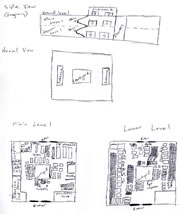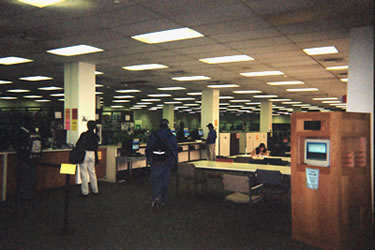
I decided to do my mini-ethnography on the undergraduate
library located behind Foellinger Auditorium. I figured to do my project on
the library because I felt that it has a lot to offer and not everyone knows
what is in it. The undergraduate library is one of the most popular libraries
on campus. It is square shaped and looks as if the middle square was
cut out. It consists of three floors in total in which the main two floors
are underground. The above ground floor just serves as an entrance to
the bottom two: the main level and the lower level. There are a total
of two entrances, one at each side of the square shape. The undergraduate
library also has a tunnel that leads to the main library (Main Stacks),
so you wouldn't have to go outside. Before doing research and spending
time in the undergraduate library, I figured that all libraries on campus
acted as a place to do research, because of their great selection of
books, a place to check out books that are needed, and a place to get
some studying done. In the end, there is a lot more offered at the undergraduate
library, and probably at many other libraries on campus also.
There are many types of workers at the undergraduate
library whom all serve a different purpose. The one group of workers, which
most think about off the top of their heads, are the ones that organize the
bookshelves. These workers walk around with carts of books and organize them
into the other books in the correct order. They are also sometimes able to
help you find something you might be looking for.
Then there are the workers
that sit behind the circulation desk. This is where you check out books and
where you would come to drop them off. These workers can show you where pretty
much anything is and they can also answer many of the questions you have which
deal with the library in general. I have noticed that while they are waiting,
they sit behind computers. Some might be doing homework, since some workers
are students, while others might be surfing the Internet. There are usually
about two to three workers always at the circulation desk.
The reference desk
is another important place in the library. I have never known of anything like
it except for now. As I was observing, I noticed that it had its own little
station. There was one worker there at the time of my observations. The worker,
Meghan, was willing to help me in finding out what the reference desk is all
about. Meghan is a graduate assistant working at this station. When I asked
her what her job consists of, she stated, "I
help people with any type of reference work." I didn't really understand
what she totally meant by this, so I asked her, "In what way do you
help people?" She responded, "I usually help students find reference
books, or find reference materials through the online catalog." After
I asked her a couple questions, I watched to see how she helped others. While
observing Meghan, I would see her, every now and then, over-the-should of
someone, helping them with what ever they were working on, on the computer.
As she helped one student she would point at the screen, as to tell him where
to click, or she would take the mouse and show him. Overall, she seemed to
be a very helpful and respectful worker.
The last area, which I had the wrong
idea about, was the reserve desk. I always thought that this was the area
where you can put certain sources on reserve, hence the name "reserve
desk." But then again, I figured, "Why
would someone put something on reserve when they can just look at it or check
it out?" After talking with one of the two workers in this area, I found
out what it is really about. I found out through Chanell that the reserve
area is a place where professors put books, videos, and soundtracks on reserve
for students to come and research. These sources, on the shelves behind the
desk, can be sources brought over from any other library on campus. Chanell
also stated that students can only check them out for a period of two hours
at a time and cannot leave the library with them. These sources pretty much
act as reference sources.
